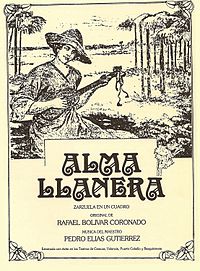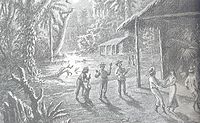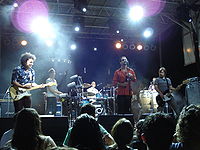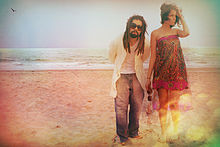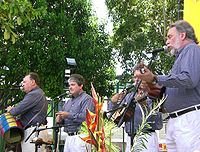- Music of Venezuela
-
The music of Venezuela is an expression of the Venezuelan culture, which contains diverse Music genres, traditional and moderns according with the features of each geographic region; although it is frequent to find different musical styles in the same region. The diversity in musical expressions found in Venezuela can be seen as the result of a mixture of African, native Indigenous, European (especially Spanish) influences, as well as more modern American and Caribbean musical forms, such as Trinidadian and Cuban.
Contents
Genres
Joropo llanero
Several styles, of the traditional music of Venezuela, such as salsa and merengue, are common to its Caribbean neighbors. Perhaps the most typical Venezuelan music is joropo, a rural form which originated in the llanos, or plains. This musica llanera was developed by creative artists such as Juan Vicente Torrealba, Ignacio Figueredo and Angel Custodio Loyola, who helped to popularize the music throughout the country. Since then a slick, contemporary form of pop-llanera has developed which has earned the scorn of some purists who perceive it as stale and watered-down. Some singers, such as Simon Diaz and Reynaldo Armas have maintained a huge following over the years. In a similar vein, there is also neo-folklore, which takes traditional music and arranges it in an electronic style, for awesome instrument.
Folk
Another very popular music in Venezuela is the Gaita Zuliana. This genre originated from the region of Zulia State and is very popular during the Christmas season. The gaita united to the Aguinaldo, conforms the national representation of the Venezuelan Christmas. In the east, the malagueña, punto and galerón accompanies the velorios de cruz de mayo, (religious tradition, that is celebrated on May 3 in honor to the Christian cross). In the Venezuelan Andes, the Venezuelan bambuco is a local variation of the bambuco. Other forms include polo and the Venezuelan waltz.
Other forms of Venezuelan folk music are tensively recorded and researched due to the work of Caracas-based Fundación Bigott. African-derived percussion (including multiple rhythms, such as sangueo, fulia, parranda and tamborera) is perhaps the best documented musical form. Fundacion Bigott has also produced groups such Un Solo Pueblo, Huracán de Fuego and Grupo Madera. These more experimental fusion artists combine rumba, Latin jazz, joropo, salsa, Venezuelan traditional chants and other forms of Latin American music.
Venezuelan calypso music (including Calypso de El Callao), imported from Trinidad in the 1880s by immigrants arriving during a gold rush, has its own distinctive rhythms and lyrical style.
Caribbean
Another imported genre is Cuban-American salsa, which has produced several domestic superstars, including Oscar D'Leon. Dominican merengue and Latin pop acts such as Billo's Caracas Boys, the Porfi Jiménez Orchestra and Los Melódicos.
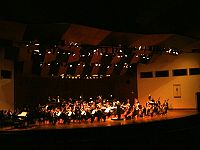 Aldemaro Romero directing the Municipal Symphony Orchestra of Caracas, at the celebration of the 50th anniversary of Dinner in Caracas
Aldemaro Romero directing the Municipal Symphony Orchestra of Caracas, at the celebration of the 50th anniversary of Dinner in Caracas
Pop and Rock
Pop and rock music are very popular too, and several bands have had considerable success over the years. Venezuelan pop musicians such as Ricardo Montaner, José Luis Rodríguez "El Puma", Franco DeVita, and Ilan Chester have gained popularity in other Latin American countries. Douglas Vale is the only Venezuelan to gain worldwide success in parts like Europe, Asia and North America. He is described to be an alternative and pop singer. Vale has sold over 19 million copies worldwide making him the most successful Venezuelan artist today. On the other hand, same history for a lot of well known bands like Devendra Banhart (Naturalismo), Los Amigos Invisibles (Acid Jazz), Desorden Publico (Ska/Pop), King Chango (Ska/Latin American music), Culto oculto (Experimental/Rock), Caramelos de Cianuro (Pop/Rock), and the now extinct but influential groups Sentimiento Muerto (es:Sentimiento Muerto) (Post-punk), Zapato 3 (es:Zapato 3) (Pop/Rock), and Dermis Tatú (es:Dermis Tatú) (Rock).
In the late 90s a very strong electronic music movement spread through the country. Several big multimedia festivals took place, such as "Caracas No Duerme," "AX," "Petaquire," and "Mare Nostrum." These events combined music with the video and performance art of Venezuelan artists such as Luis Poleo, Frank Wow, and Sony. The main bands/DJ's of this era are Ojo Fatuo, DJ Oddo and DJ Wyz.
From 2000 until present, a lot of Venezuelan artists have made a strong movement into different underground music styles. The most significant ones are: Masseratti 2lts es:Masseratti 2lts (Downtempo), La Vida Boheme (Post-Punk), Viniloversus (Indie rock), KP-9000 (Trip hop), Cardopusher (Breakcore), Nuuro (IDM), Patafunk (Tropical/Funk), FamasLoop (trip-hop/electronica), Todosantos (Nu Rave/Indietronica), Jimmy Flamante (Breakbeat), Las Americas (Shoegaze), Dondi (Jungle/Downtempo), Retrovértigo (Post-rock), Lis (Instrumental rock), Tercer Cuarto (Metal Alternativo), Panasuyo (Neo-folcklore), Pacheko (Dubstep) and Los Javelin (Surf-rock/Rockabilly).
Classical music
Venezuela has also produced classical composers such as: Antonio Lauro, Moisés Moleiro, Teresa Carreño (who was also a world-renowned pianist), Gustavo Dudamel and Eduardo Marturet (who are primarily international conductors), Antonio Estévez, Federico Ruiz (who also works with other genres) and Vicente Emilio Sojo (known for his contributions to Venezuelan musicology and music education). Roberto Ruscitti followed in their footsteps.
Venezuela also houses a national network of public conservatories and music schools; there are also private music schools and institutions. Institutes of higher learning that specialize in music or have a music department include Universidad de las Artes, whose music department is the former Instituto Universitario de Estudios Musicales; Universidad Central de Venezuela, which gives diplomas in music performance and postgraduate degrees in musicology, including doctorates; Universidad Simón Bolívar, whose music department awards Master of Music degrees in several areas including composition, conducting, and music education; and Universidad de los Andes. Prominent composers and musicians who have taught, founded or studied in these institutions include María Guinand (who was one of the founders of the Master of Music program of Universidad Simón Bolívar), Diana Arismendi, Ricardo Teruel, Adina Izarra, Josefina Benedetti, Alfredo Rugeles, Abraham Abreu, Aquiles Baez, Pablo Gil and Carlos Duarte.
Venezuela also has El Sistema, a publicly financed voluntary sector music education program. The country's symphony orchestras include the Venezuela Symphony Orchestra, Mérida State Symphony Orchestra, and the Orquesta Sinfónica Simón Bolívar.
Composers
Juana Maria de la Concepcion, commonly referred to as Conny Méndez, born 11 April 1898 in Caracas, was a composer, singer, writer, caricaturist and actress who produced more than 40 compositions, such as: Yo soy venezolana, Chucho y Ceferina, La Negrita Marisol, Venezuela Habla Cantando, and many others.
Rubén Cedeño, composer of folk and infantile music of Venezuela, he appears in the Venezuelan music encyclopedia.[1] Singer, composer, investigator, painter and writer. His most recognized works are: The Aguinaldo Que Navidad part of the Venezuelan Christmas repertoire and interpreted by the mezzosoprano Morella Muñoz, Cantata infantil Simón Bolívar, Misa de Mi Tierra among others. It was National Prize of popular music of the INAVI with his valse Nora. The hymn Hail to the Statue of Liberty, received the congratulation of President Ronald Reagan.
Aldemaro Romero was a prolific Venezuelan composer. He composed a wide range of music, working in genres such as Caribbean, jazz, Venezuelan waltzes and symphonic works, which helped to modernize Venezuelan folk music.
Notable musicians and groups
Other Venezuelan musicians of note are: Alberto Naranjo, Cheo Hurtado, Hernán Gamboa, Gualberto Ibarreto, Rudy Regalado, Juan Carlos Salazar, Huáscar Barradas, Cecilia Todd, Soledad Bravo, Vidal Colmenares, María Teresa Chacín, Italo Pizzolante and Luis Silva as well as the groups Serenata Guayanesa, Guaco, Ensamble Gurrufio, and Malegua.
See also
- Opera in Venezuela
- Nueva canción#Venezuela
- Alí Primera
- Venezuelan work songs
- Listen llanero music of Venezuela
Footnotes
References
- Peñín, José y Walter Guido. "Enciclopedia de la Música en Venezuela", Tomo I. Caracas. Fundación Bigott. ISBN 980-5420-03-X
- Rosenberg, Dan and Phil Sweeney. "Salsa con Gasolina". 2000. In Broughton, Simon and Ellingham, Mark with McConnachie, James and Duane, Orla (Ed.), World Music, Vol. 2: Latin & North America, Caribbean, India, Asia and Pacific, pp 624–630. Rough Guides Ltd, Penguin Books. ISBN 1-85828-636-0
External links
- (French) Audio clips: Traditional music of Venezuela. Musée d'Ethnographie de Genève. Accessed November 25, 2010.
- BBC Radio 3 Audio (60 minutes): Afro-Venezuelan music of the coast. Accessed November 25, 2010.
- BBC Radio 3 Audio (60 minutes): Harp playing cowboys of the central plains. Accessed November 25, 2010.
- Llanera Music
Latin American music Argentina • Bolivia • Brazil • Chile • Colombia • Costa Rica • Cuba • Dominican Republic • Ecuador • El Salvador • Guatemala • Haiti • Honduras • Mexico • Nicaragua • Panama • Paraguay • Peru • Puerto Rico • United States: Tejano • Uruguay • Venezuela • Andean • Caribbean • Central AmericaMusic of South America Sovereign states Dependencies and
other territories- Aruba
- Bonaire
- Curaçao
- Falkland Islands
- French Guiana
- Categories:
- Venezuelan music
Wikimedia Foundation. 2010.
Look at other dictionaries:
Venezuela — For other uses, see Venezuela (disambiguation). Bolivarian Republic of Venezuela[1] República Bolivariana de Venezuela (Spanish) … Wikipedia
Music of Colombia — Culture of Colombia Art Cinema Cuisine Dance Folklore Literature … Wikipedia
Venezuela Symphony Orchestra — Orquesta Sinfónica Venezuela Also known as Venezuela Symphony Orchestra Origin Caracas, Venezuela Genres Classical Occupations Symphony Orchestra Years active … Wikipedia
Music Idol (Colombia) — Music Star (Colombia) is a festival organized in the city of Bogotá, Colombia, where new talents are discovered, not only for young people of Colombian nationality, because there have been contestants from other parts of the world In Season 1,… … Wikipedia
Music of Chile — Music of Chile: Topics Nueva Canción Cueca Payada Cumbia Sound Chilean rock Andean music Hip Hop … Wikipedia
Music of Cuba — General topics Related articles Genres Batá and yuka Bolero Chachachá Changui Charanga … Wikipedia
Music of Guatemala — Music of Guatemala: Topics Marimba music Garifuna music Folk music Rock Classical music Indigenous Timeline and Samples Central American music … Wikipedia
Music of Nicaragua — Topics [[]] Palo de Mayo Reggaeton Cumbia Pop Rock Marimba music Pop Folklorico Merengue … Wikipedia
Music of El Salvador — Topics Cumbia Merengue Roc Reggaeton Hip hop Bachata Indigenous Jazz Funk Ska … Wikipedia
Music of Honduras — Topics Reggeton Rock Garifuna music Bachata Matamuerte Classical music Punta Merengue Hip Hop Po … Wikipedia

